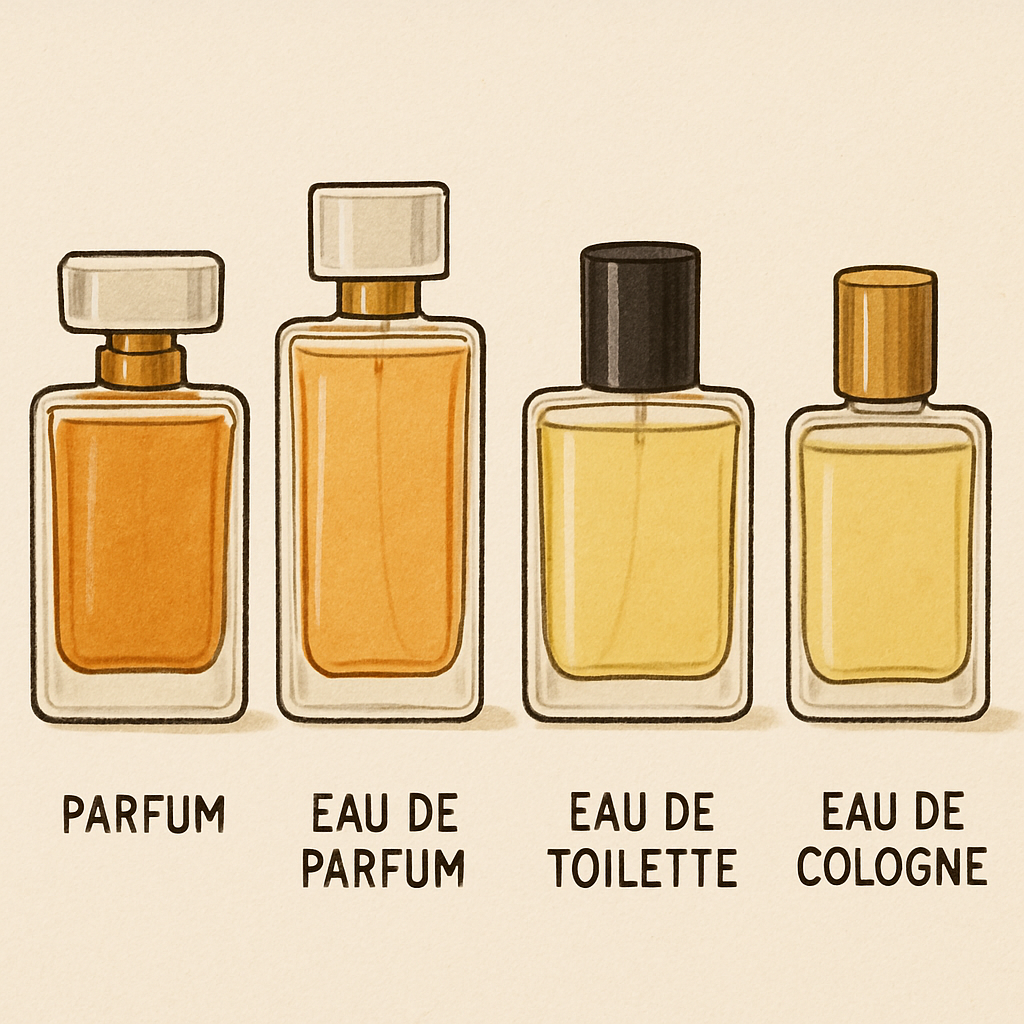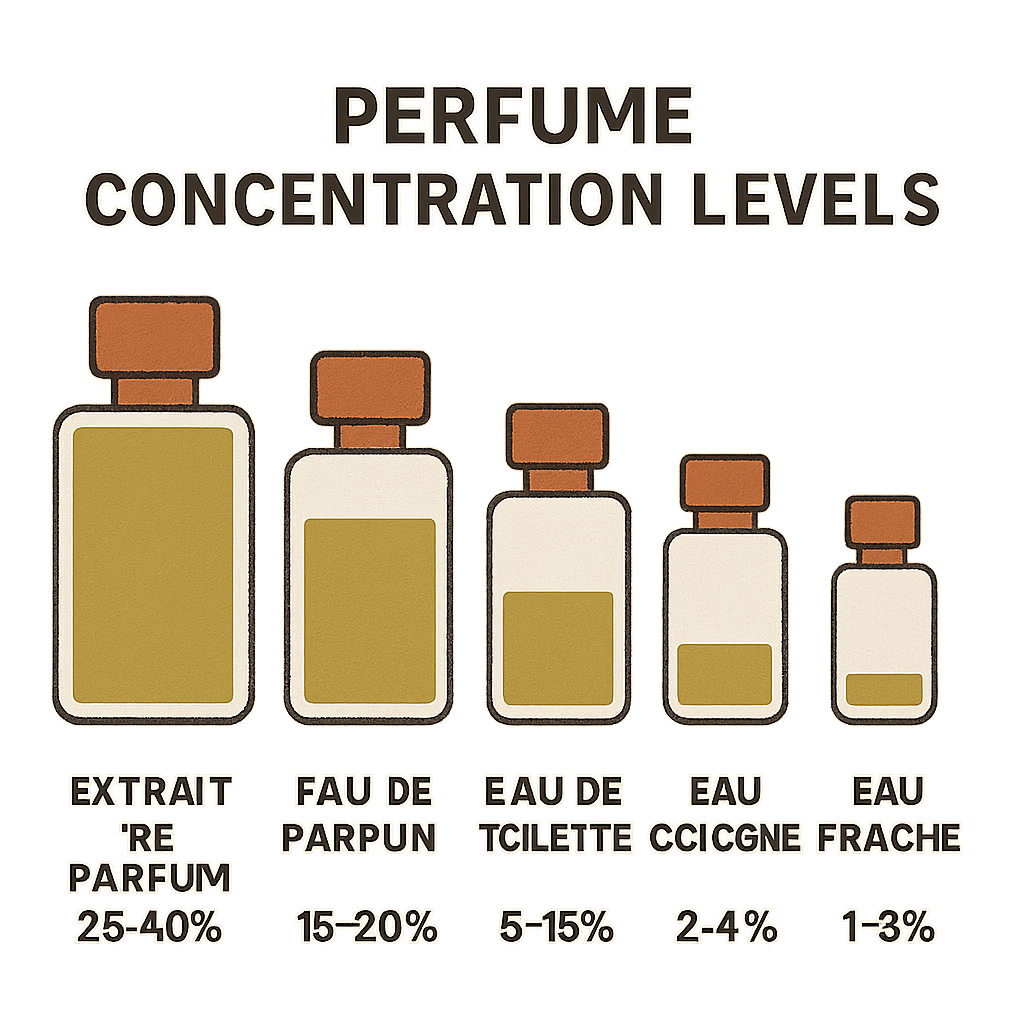Perfume Concentration Scales
Perfume concentration scales are key to understanding fragrances. They determine a perfume's strength and how long it lasts.
These scales guide you through the world of scents, helping you choose the right fragrance.
From Parfum to Eau Fraiche, each type offers a unique experience.
Understanding these scales can enhance your fragrance journey, making it more personal and satisfying.
Dive into the art of perfumery and discover how concentration affects your scent choices.
What Are Perfume Concentration Scales?
Perfume concentration scales measure the ratio of fragrance oils to other components in a perfume. These components include alcohol and water.
The percentage of fragrance oil defines how strong and long-lasting a perfume is. Higher concentrations mean more intensity and longer duration.
Here's a quick breakdown of perfume concentration categories:
- Parfum: 20-30% fragrance concentration
- Eau de Parfum (EDP): 15-20%
- Eau de Toilette (EDT): 5-15%
- Eau de Cologne (EDC): 2-4%
- Eau Fraiche: 1-3%
Understanding these scales helps in selecting perfumes suited to your preferences and occasions.
Different occasions and personal tastes influence which concentration is best. For special events, high-concentration perfumes like Parfum may be ideal.
The Main Perfume Concentration Categories
Perfume concentrations determine the potency and longevity of a fragrance. They are typically classified into five main categories.
These categories, in order of decreasing concentration, are:
- Parfum (Extrait de Parfum)
- Eau de Parfum (EDP)
- Eau de Toilette (EDT)
- Eau de Cologne (EDC)
- Eau Fraiche
Understanding each type helps in choosing the right scent for any occasion. Different concentration levels cater to various preferences and needs.
Parfum (Extrait de Parfum)
Parfum, or Extrait de Parfum, contains the highest concentration of fragrance oils. Its concentration ranges from 20-30%.
This high concentration ensures the longest-lasting scent. It can linger on the skin for up to 24 hours.
Key characteristics of Parfum include:
- Rich and intense fragrance
- Long-lasting sillage
- Higher price point due to concentration
Its intensity makes it suitable for evenings or formal events. Many prefer it for occasions where impact matters.

Eau de Parfum (EDP)
Eau de Parfum (EDP) offers a strong fragrance with a concentration of 15-20%. It strikes a balance between strength and wearability.
EDP is a popular choice for daily wear or special occasions. It lasts up to 8 hours on the skin.
Features of Eau de Parfum include:
- Moderate to strong intensity
- Good longevity
- Versatile for various settings
Its popularity stems from its perfect blend of durability and intensity. Many individuals enjoy its lasting scent throughout the day.

Eau de Toilette (EDT)
Eau de Toilette (EDT) is lighter, with a concentration of 5-15%. It suits everyday use due to its subtler scent profile.
EDT typically lasts between 4 to 6 hours. It offers freshness without overwhelming the senses.
Highlights of Eau de Toilette include:
- Lighter scent compared to EDP
- Ideal for day-to-day wear
- Affordable price range
Its accessibility and freshness make it a common pick for casual or daytime occasions. Many appreciate its light, airy aroma.

Eau de Cologne (EDC)
Eau de Cologne (EDC) features a fragrance oil concentration of 2-4%. This makes it one of the lightest in intensity.
It provides a refreshing and brief scent experience, lasting up to 2 hours.
Benefits of Eau de Cologne include:
- Refreshing and subtle scent
- Short-term fragrance ideal for quick refresh
- Economical choice
EDC is often used for its invigorating touch, perfect for the mornings or summer days. Many enjoy its crisp scent without the weight.

Eau Fraiche
Eau Fraiche contains the least fragrance concentration, about 1-3%. It is mostly composed of water.
This option is suitable for a very light and airy scent. It lasts for a minimal period, up to an hour.
Eau Fraiche key traits are:
- Water-based, gentle application
- Ideal for very casual settings
- Minimal fragrance strength
Used often in casual or sports scenarios, Eau Fraiche provides a quick spritz of freshness. Many appreciate its gentle, discreet quality.

Perfume Composition: Understanding Notes and Structure
Perfume composition is a complex art that layers various scent notes. These notes unfold over time, creating a dynamic fragrance experience. Understanding their structure can enhance one's appreciation of a perfume's character.
Perfumes are typically composed of three main types of notes:
- Top Notes
- Middle Notes (Heart Notes)
- Base Notes
Top notes are the initial scents experienced immediately upon application. They're often fresh and fleeting, captivating the senses and setting the tone for the fragrance. They last only a few minutes to an hour.
Middle notes, or heart notes, develop as the top notes fade. These form the core of the fragrance, typically lasting for several hours. They give depth and character to the perfume, often featuring floral or spicy elements.
Base notes are the foundation, emerging as the fragrance settles. These are rich, long-lasting scents that can persist for hours, even after the middle notes have dissipated. They often include ingredients like vanilla, amber, or musk.

Perfume Types and Scent Families
Perfume types can be diverse, reflecting a rich array of scent families. Each family tells a unique olfactory story. They offer distinct moods and experiences.
Scent families provide a helpful framework for understanding perfume types. These families include:
- Floral
- Oriental
- Woody
- Fresh
Floral perfumes capture the essence of flowers like rose and jasmine. They exude romance and softness. Oriental perfumes, with warm, spicy notes like vanilla and amber, are rich and exotic. These perfumes convey warmth and opulence.
Woody perfumes are characterized by scents of sandalwood and cedar. They offer earthy and grounding aromas, while Fresh scents focus on lightness, using citrus and aquatic notes to evoke clean, breezy sensations.
Understanding these scent families can guide you in selecting perfumes that resonate with your personal style. Each family offers its own allure, enhancing your fragrance experience and personal expression.

How Concentration Affects Longevity, Sillage, and Price
Perfume concentration scales greatly influence a fragrance's longevity, sillage, and cost. The higher the concentration, the longer the scent lasts on your skin. This longevity means fewer reapplications, making it ideal for those who seek all-day wear.
Sillage is the aromatic trail left behind by a fragrance. High-concentration perfumes like Parfum and Eau de Parfum offer a stronger, more pronounced sillage, captivating those nearby. In contrast, lighter concentrations like Eau de Toilette and Eau Fraiche provide subtler sillage, suitable for intimate settings or daily use.
The concentration of a perfume also impacts its price. More concentrated perfumes require larger amounts of fragrance oils, which raises production costs. This often results in higher prices. However, the investment can be worthwhile, considering the extended wear and impact these perfumes offer.
- Longevity: Time the scent lasts
- Sillage: Fragrance trail
- Price: Higher concentration costs more

Choosing the Right Perfume Concentration for You
Selecting the best perfume concentration depends on several factors, including occasion, skin type, and personal preference. Consider what kind of fragrance experience you desire. Do you prefer a strong, long-lasting presence or something light and fresh?
For formal events or evenings, a higher concentration like Parfum or Eau de Parfum may be more appropriate. These offer richer, longer-lasting aromas. For daily wear or warmer climates, lighter options such as Eau de Toilette or Eau Fraiche could be ideal. These are perfect for a more understated effect.
When choosing, also think about how your skin reacts to fragrances and your budget. Sampling different concentrations is key to understanding what suits you best.
- Occasion: Formal vs. casual
- Climate: Warm vs. cool
- Preferences: Strong vs. subtle

Tips for Sampling and Layering Perfumes
Sampling fragrances before buying is crucial. It allows you to test how the scent interacts with your skin over time. Apply on pulse points and observe the changes throughout the day. This helps in understanding the full range of top, middle, and base notes.
Layering different perfumes can create a signature scent. Begin with lighter concentrations, then layer with a heavier one for depth and uniqueness. Experimenting with fragrance combinations lets you personalize your scent profile.
- Test on skin: Fragrance reacts differently than on paper
- Start simple: Combine complementary notes
- Consider timing: Morning vs. evening for different effects

Frequently Asked Questions About Perfume Concentration Scales
What does perfume concentration mean?
Perfume concentration refers to the strength of the fragrance oils in the bottle. It determines how intense and long-lasting the scent will be. Higher concentrations usually mean stronger and longer-lasting fragrances.
How do I choose the right concentration?
Consider the event and your personal preference when choosing a concentration. For daily wear, lighter concentrations like Eau de Toilette might be preferable. For special occasions, a Parfum or Eau de Parfum could be more suitable.
Why do prices vary with concentration?
Higher concentrations contain more fragrance oils, making them more costly to produce. This results in a noticeable price difference between concentrations.
- Concentration levels: Parfum > Eau de Parfum > Eau de Toilette
- Application suitability: Daily vs. special occasions
- Cost implication: Higher concentration, higher price
Conclusion: Enhancing Your Fragrance Experience
Understanding perfume concentration scales can transform how you experience fragrances. With this knowledge, you can better appreciate the nuances of different scent profiles. It also helps you choose the right perfume for every occasion.
Your fragrance journey becomes more personalized and fulfilling as you explore various concentrations and compositions. Keep experimenting to find scents that resonate with you. By doing so, you’ll enhance not just the fragrance experience but also your confidence and self-expression.

